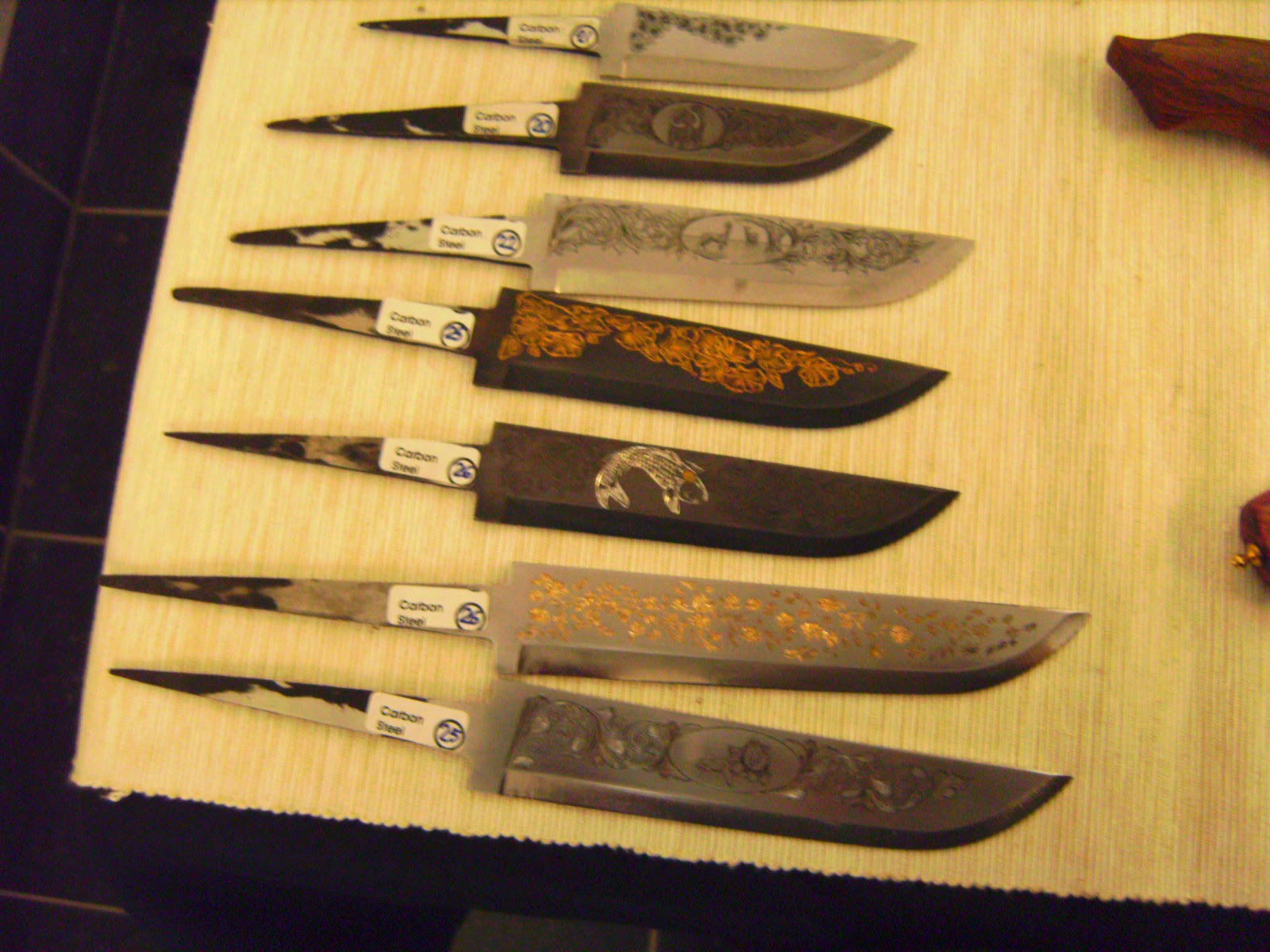I, for one, am still on the track of the so - called "Brackersfelder Knopmetz" (See another post), a short dagger or knife native to the region I live in which is said by many to have legendary metallurgical and artificial properties.
Thusly, I was impressed by the presence of those knives. Left is a dagger that might as well have the looks of the "Knopmetz". How it actually looked, is still a mystery to me. I presume there were two varieties. One, referred to as the "Brackersfelders dehhen" in judicial documents and archives of stock of the time in question, would have been a dagger. For an example of the "Knopmetz", however, look here. The knife in question looks as if it were single-edged, has a "Knop" (pommel) and was often made with precious mountings. The "dehhen" presumeably was double-edged. The photo above shows a "Hauswehr" (home-defence) in the middle and a utility design very common in the North of Germany, albeit with very precious handle materials. The knife to the left is typical of the "Holbein" variety. If you compare it to the "Brackersfelders Knopmetz" in the article you can see several similarities. Crucial to the Knopmetz is therefore:
-a long, small, single-edged blade (whether the long ricasso is characteristical, remains to be examined)
-an ornamental crosspiece
-a pommel (hence the name)
-a special steel alloy which is due to the alloy resulting from the iron ore found in the mines around Breckerfeld, which I estimate as containing iron, a high carbon content, and manganese and silicium. This steel was said to have superior characteristics, to an extent that there was a legal affair in 1490 concerning the faking of the Breckerfeld sigil marker on steel that actually came from the Siegerland region. It is quite obviously stated in the documents in the city archive of Breckerfeld that the Siegerland steel (which was renowned in the entire known world in 1490 for its quality) was inferior by far to the quality of steel smelted in Breckerfeld. Which leads me to the question, what would a bladesmith regard as superior in 1490?
I guess there are two facets of the question. A steel that was at the same time taking a good temper as well as retaining a high amount of flexibility was rare, but since the excellent experimental replica of the Ulfberht swords we can quite safely assume that while the crucible steel smelting process might not be commonplace in the medieval ages, there might have been smiths still knowing the how - to in 1490. Many Frankish swords have been suspected to be made from crucible steel. Refined crucible steel is one way to achieve a blade that is taking a high temper as well as maintaining an amazing amount of flexibility. Having had the privilege to work with historical (pre-1920) tool steel, I can say the mechanical properties are quite amazing and maybe even up to par with the famed Wootz or the Russian or Turmenian Pulad. My theory now is that the Brackersfelders Knopmetz actually was made from a variety of steel that was similar to Wootz. It could be, since Breckerfeld was a Hanse community then, and the Hanse traded throughout Europe and, over small factories in Russia, maybe even from Asia, that the technology was transferred from Russia, if it were not known in the region in the first place. You can find quartzite in the vicinity of Breckerfeld, this might have been used as a cooling medium, and, in the process, added Silicium to the alloy. The iron ore found seems to be often "contaminated" with Manganese, which, when smelted and refined, would make for a steel with properties similar to modern 1.2842 or spring steel. There´s still much to investigate, and there´s a goopd thing!
Eloquent short sword from 1600.
A disc-pommel dagger with a triangular blade.
The blade in good condition.
To the right is a Renaissance sword, a so - called "Cinquedea" or "Ox tongue" for the width of the blade, originally an Italian weapon.
A most eloquent example of a Rondel or "ear dagger", presumeably used in a reverse handle grip with the thumb resting between the two pommel discs.
An unusual example of the "Grosses Messer", a sword popular with German mercenaries throughout the medieval age.
Rapier, "Katzbalger" short sword and left-hand dagger.
Above you can see a utility peasant knife, made from massive steel. Knives like these were cheap and tough and ideally suited for hard working on a farm.
With the strengthening of civilian culture there was also a movement towards table culture. A set of table cutlery from the 17th century.
17th century table cutlery. A royal decree demanded that knives for table use had blunted tips.
Table knives since look this way.
Although here you can see a fine example of a personal wayfarer´s traveling set.
...
...
...
And another ensemble of sabres and "Grosse Messer".
As I might have illustrated, if you are interested in historical developments of arms and cutlery alike, this is the place;-).
Visit this museum, it´s well worth it;-)...




























































































